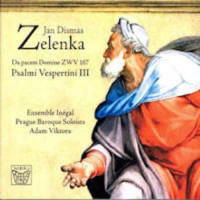Texte paru dans: / Appeared in: Code-barres / Barcode : 8595056601643 |
|
|
Reviewer: Bertil
van Boer
Nibiru has delivered here the
third of four discs devoted to the Psalmi Vespertini by Jan Dismas Zelenka,
one of the Baroque’s most proficient composers. As noted elsewhere in this
issue, these form a body of work that was put together by the composer
himself as a set or sequence of various motet-cantatas for Vespers. Here we
have eight in the group, all apparently composed around 1728 for services in
the Marienkirche in Dresden, where Zelenka was Kapellmeister. He entered
them in a special catalog about 1728, forming three cycles (the Psalmi
Vespertini II has been reviewed elsewhere, and the fourth group, the Psalmi
Varii, forms a later addition). Zelenka was particularly focused on music
for the Vespers services, for in addition to his own set, he apparently
obtained copies of almost 90 additional pieces by various composers
throughout Europe. Unfortunately, the third set is missing six works (and
has been since the 18th century), which makes it incomplete. No matter; what
survives is a fitting end to the cycle, though one might regret the lacuna
for what it would have contained.
From a scoring standpoint, all
of these works are rather sparsely orchestrated, with only a pair of oboes
and a bassoon complementing the strings, but in keeping with the other sets,
the solo and choral writing is tightly gathered. Of the eight remaining
pieces, five are receiving their modern premieres on this disc. The first of
these, Confitebor tibi Domine (ZWV 70) opens with lazy and flowing melody
that is a good foundation for the solo tenor and bass, and later soprano and
alto, in duet. The alternation between soloists and the instrumental
ritornellos reminds one of a Bach Passion in the even flow. The Redemptionem
misit is forceful and decisive, quite homophonic in structure, but this only
sets up the floating contrapuntal cantus firmus Amen. The second is the
three-movement In convertendo (ZWV 91), which begins with a chromatically
gnarly choral line that seems more episodic than fugal, despite the
imitative entrances. The doxology follows Zelenka’s usual pattern of a slow
and thoughtful Gloria patri which introduces the final Sicut erat fugue. The
soloists in the first are quite ethereal. The single-movement Beatus vir has
a quite challenging tenor line, which runs and skips with some nice
coloratura before the static chorus enters. The final doxology is woven into
the line and features the two soprano soloists weaving about before the
mildly contrapuntal choral finale. The Confitebor Angelorum (ZWV 100) could
have been written for an oratorio by Handel, with its steady but rapid
walking bass line above which one finds the alto solo entering in
counter-point, and concluding with a rather interesting choral part that
sometimes is surprising in its melismas and leaps in the voice-leading. Like
the others, the final portion of the doxology is an imitative double fugue
that seems rather less strict than episodic. The final premiere is the
three-movement Domine probasti me (ZWV 101), in which the main section seems
a bit more modern in the short introduction and focused on the soloists, who
weave a nice little arabesque until the homophonic choral entrance, and the
work continues alternating free polyphony with choral homophony in a
relentless manner. The doxology here repeats the pattern instead of a
conventional fugue during the Sicut erat portion.
Of the three other
cantata-motets, the In exitu Israel (ZWV 84) is the most Bachian (or rather
Zelenkan), with its soaring soprano choral cantus firmus above the
contrapuntal lower voices, but the short introduction leads to the gentle
Simulacra gentium. The doxology repeats the opening style, thought the
counterpoint underneath is far more aggressive. The Laudate Dominum (ZWV 87)
has a nice interplay between the tenor and chorus, both with some rather
impressive figuration. It is quite short, and the concluding Amen movement
is almost as long as the main section. The Memento Domine David (ZWV 98) is
slow and stately, with a rather lyrical opening movement with the usual
alteration between soprano solo and orchestra. The Si custodierint reduces
the forces accompanying the tenor (and later bass) solo to the continuo,
with the instruments acting as a connecting ritornello.
The pieces of the cycle are
rather short, and therefore it is necessary to insert at the beginning an
anomalous work, the Da pacem Domine (ZWV 167), which otherwise doesn’t
belong to the cycle. This is a good introduction, as it builds with slowly
unfolding choral statements above a softly swirling violin accompaniment in
the first movement. The second is more lively, with some good contrapuntal
writing, though not fugal in the slightest. These works are a fitting conclusion to the three cycles and demonstrate that Zelenka was quite inventive in his music, though he does follow some recognizable patterns, particularly in the doxologies. These are fully developed by the excellent performance of the Prague Baroque Soloists and their choral counterpart, the Ensemble Inégal, whose clarity and diction make these works come alive. All four of the Vespers cycle discs should be a part of any collection of Baroque sacred music, as they are some of the most interesting and inventive of the period. Highly recommended. | |
|
|
|
|
|
|
|
Cliquez l'un ou l'autre
bouton pour découvrir bien d'autres critiques de CD |
|




